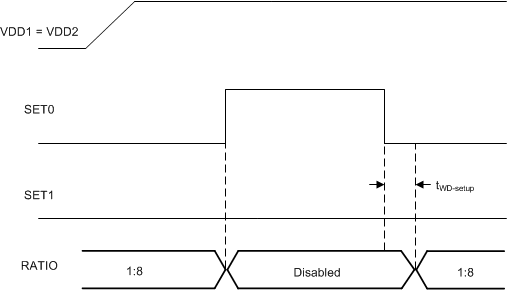JAJSFU1A July 2018 – September 2021 TPS3430-Q1
PRODUCTION DATA
- 1 特長
- 2 アプリケーション
- 3 概要
- 4 Revision History
- 5 Pin Configuration and Functions
- 6 Specifications
- 7 Detailed Description
- 8 Application and Implementation
- 9 Power Supply Recommendations
- 10Layout
- 11Device and Documentation Support
- 12Mechanical, Packaging, and Orderable Information
7.3.2.1.1 Enabling the Window Watchdog
The TPS3430-Q1 features the ability to enable and disable the watchdog timer. This feature allows the user to start with the watchdog timer disabled and then enable the watchdog timer using the SET0 and SET1 pins. The ability to enable and disable the watchdog is useful to avoid undesired watchdog trips during initialization and shutdown. When the SETx pins are changed to disable the watchdog timer, changes on the pins are responded to immediately (as shown in Figure 7-2). When the watchdog goes from disabled to enabled, there is a 150 μs (tWD-setup) transition period where the device does not respond to changes on WDI. After this 150-μs period, the device begins to respond to changes on WDI again.
 Figure 7-2 Enabling the Watchdog Timer
Figure 7-2 Enabling the Watchdog Timer